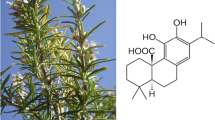Abstract
Carnosine is a known protector of neuronal cells against oxidative injury which prevents both apoptotic and necrotic cellular death. It was shown earlier that carnosine serves as an intracellular buffer of free radicals. Using the model of ligand-dependent oxidative stress in neurons, we have shown that homocysteine (HC) initiates long-term activation of extracellular signal regulated kinase, isoforms 1 and 2 (ERK 1/2) and Jun N-terminal kinase (JNK) which corresponds to exitotoxic effect resulting in cellular death. l-Carnosine (β-alanyl-l-histidine) protects neurons from both excitotoxic effect of homocysteine and cellular death. Its analogs, β-alanyl-d-histidine (d-carnosine) and l-histidyl-β-alanine, restricted accumulation of free radicals and delayed activation of ERK1/2 and JNK in neuronal cells, but did not promote neuronal viability.



Similar content being viewed by others
References
Aruoma OI, Laughton MJ, Halliwell B (1989) Carnosine, homocarnosine and anserine: could they act as antioxidants in vivo? Biochem J 264(3):863–869
Boldyrev AA (1993) Does carnosine possess direct antioxidant activity? Int J Biochem 25(8):1101–1107
Boldyrev AA (2003) Significance of reactive oxygen species for neuronal function. In: Tomasi A et al (eds) Free radicals, NO, and inflammation molecular, biochemical and clinical aspects. IOS Press, pp 153–169
Boldyrev A (2007) Carosine and oxidative stress in cells and tissues. NovaPubl, New York
Boldyrev A (2009) Molecular mechanisms of homocysteine toxicity. Biochemistry (Mosc) 74(6):589–598
Boldyrev A (2011) Carnosine—new concepts for the old molecule. In: Carnosine in exercise and disease. Abstract book of international congress, Ghent, p 2
Boldyrev AA, Dupin AM, Bunin AY, Babizhaev MA, Severin SE (1987) The antioxidative properties of carnosine, a natural histidine containing dipeptide. Biochem Int 15:1105–1113
Boldyrev AA, Song R, Lawrence D, Carpenter DO (1999) Carnosine protects against excitotoxic cell death independently of effects on reactive oxygen species. Neuroscience 94:571–577
Boldyrev A, Arzumanyan E, Kulebyakin K, Berezov T (2011) Novel mechanisms of regulation of brain plasticity. Neurochem J 5(4):301–305
Calabrese V, Cornelius C, Mancuso C, Pennisi G, Calafato S, Bellia F, Bat TE, Stella AMG, Schapira T, Kostova ATD, Rizzarelli E (2008) Cellular stress response: a novel target for hemoprevention and nutritional neuroprotection in aging, neurodegenerative disorders and longevity. Neurochem Res 33(12):2444–2471
den Heijer T, Vermeer SE, Clarke R, Oudkerk M, Koudstaal PJ, Hofman A, Breteler MM (2003) Homocysteine and brain atrophy on MRI of non-demented elderly. Brain 126:170–175
Glotin AL, Calipel A, Brossas JY, Faussat AM, Treton J, Mascarelli F (2006) Sustained versus transient ERK1/2 signaling underlies the anti- and proapoptotic effects of oxidative stress in human RPE cells. Invest Ophthalmol Vis Sci 47:4614–4623
Gu L, Hu X, Xue J, Yang J, Wan L, Ren Y, Hertz L, Peng L (2010) Potent homocysteine-induced ERK phosphorylation in cultured neurons depends on self-sensitization via system Xc−. Toxicol Appl Pharmacol 242:209–223
Jakubowski H, Zhang L, Bardeguez A, Aviv A (2000) Homocysteine thiolactone and protein homocysteinylation in human endothelial cells: implications for atherosclerosis. Circ Res 7(1):45–51
Kuleva NV, Kovalenko ZS (1997) Change in the functional properties of actin by its glycation in vitro. Biochem (Mosc) 62(10):1119–1123
Makhro AV, Mashkina AP, Solenaya OA, Trunova OA, Tyulina OV, Bulygina ER, Boldyrev AA (2008) Carnosine protects from oxidative stress induced by hyperhomocysteinemia. Neurochem J 2(3):202–208
McCurbey JA, La Hair MM, Franklin RA (2006) Reactive oxygen species-induced activation of the MAP kinase signaling pathways. Antioxid Redox Signal 8:1775–1789
Navon H, Bromberg Y, Sperling O, Shani E (2011) Neuroprotection by NMDA preconditioning against glutamate cytotoxicity is mediated through activation of ERK 1/2, inactivation of JNK, and by prevention of glutamate-induced CREB inactivation. J Mol Neurosci. doi:10.1007/s12031-011-9532-4
Oktyabrsky O, Smirnova G (2007) Red/ox regulation of cellular functions. Biochem Moscow 72:158–174
Perla-Kaján J, Jakubowski H (2010) Paraoxonase 1 protects against protein N-homocysteinylation in humans. FASEB J 24(3):931–936
Poddar R, Paul S (2009) Homocysteine-NMDA receptor-mediated activation of extracellular signal-regulated kinase leads to neuronal cell death. J Neurochem 110:1095–1106
Ries V, Silva RM, Oo TF, Cheng HC, Rzhetskaya M, Kholodilov N, Flavell RA, Kuan CY, Rakic P, Burke RE (2008) JNK2 and JNK3 combined are essential for apoptosis in dopamine neurons of the substantia nigra, but are not required for axon degeneration. J Neurochem 107(6):1578–1588
Sacco RL, Roberts JK, Jacobs BS (1998) Homocysteine as a risk factor for ischemic stroke: an epidemiological story in evolution. Neuroepidemiology 17:167–173
Seshadri S, Beiser A, Selhub J, Jacques PF, Rosenberg IH, D’Agostino RB, Willson PWF, Wolf PA (2002) Plasma homocysteine as a risk factor for dementia and Alzheimer’s disease. New Engl J Med 346:476–483
Son DO, Satsu H, Kiso Y, Totsuka M, Shimizu M (2008) Inhibitory effect of carnosine on interleukin-8 production in intestinal epithelial cells through translational regulation. Cytokine 42(2):265–276
Wang JQ, Fibuch EE, Mao L (2007) Regulation of mitogen-activated protein kinases by glutamate receptors. J Neurochem 100:1–11
Acknowledgments
The work is supported by RFBR, Grants ## 09-04-00507, 10-04-01461, and 11-04-00906.
Author information
Authors and Affiliations
Corresponding author
Rights and permissions
About this article
Cite this article
Kulebyakin, K., Karpova, L., Lakonsteva, E. et al. Carnosine protects neurons against oxidative stress and modulates the time profile of MAPK cascade signaling. Amino Acids 43, 91–96 (2012). https://doi.org/10.1007/s00726-011-1135-4
Received:
Accepted:
Published:
Issue Date:
DOI: https://doi.org/10.1007/s00726-011-1135-4



